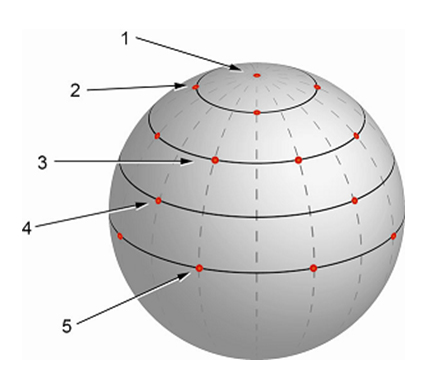Navigation
PH20 ISO10360-2 data compared to PH10
The ISO10360-2 probing test is used to establish whether the CMM is capable of measuring within the stated maximum permissible probing error MPEP by determining the range of distances of the measured points from the centre of the sphere fitted through all the probing points.
Procedure
Measure and record 25 points on the sphere, the following pattern is recommended:
- One point on the pole.
- Four points equally spaced 22.5o below the pole.
- Eight points equally spaced 45o below the pole and rotated 22.5o relative to the previous group.
- Four points equally spaced 67.5o below the pole and rotated 22.5o relative to the previous group.
- Eight points equally spaced 90o below the pole and rotated 22.5o relative to the previous group.

Derivation of results
Using all 25 measurements compute the Gaussian associated sphere. For each of the 25 measurements calculate the Gaussian radial distance. Calculate the probe error as the range of the 25 Gaussian radial distances.
Requirements
ISO10360-2:2001 test results
All these results use a PH10 mode calibration as inferred calibration has no influence on this test. The PTV* map is active where applicable.
Standard force module
Dia 4 × 12 mm stylus
PH10 | Head** | CMM*** | |
Diameter error (mm) | -0.0007 | -0.0003 | 0.0001 |
Form error (mm) | 0.0016 | 0.0011 | 0.0010 |
Dia 6 × 50 mm CF stylus
PH10 | Head** | CMM*** | |
Diameter error (mm) | -0.0013 | 0.0000 | -0.0002 |
Form error (mm) | 0.0053 | 0.0020 | 0.0012 |
EM2 standard force module
Dia 4 × 12 mm stylus
PH10 | Head** | CMM*** | |
Diameter error (mm) | -0.0014 | -0.0003 | -0.0001 |
Form error (mm) | 0.0094 | 0.0010 | 0.0018 |
* Pre-travel variation
** Head touches
*** CMM touches